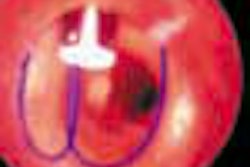SAN ANTONIO - If an institution's obstetricians and gynecologists refuse to support uterine fibroid embolization (UFE), the Internet can provide sufficient referrals to make the program successful, specialists reported at the 26th annual scientific meeting of the Society of Cardiovascular and Interventional Radiology.
Without getting a collaboration agreement with the ob/gyn department, Duke University Medical Center's department of radiology began offering the minimally-invasive UFE procedure last year -- getting most of its 37 patients from Internet inquiries.
"There were 33 self-referrals to our program," said Dr. Robert Cranley, a fellow in vascular interventional radiology.
After evaluating the women and reviewing their medical records obtained from the women's gynecologists, Duke radiologists performed UFE on 22 of the women.
"There were no late complications," said Cranley, who reported that the women underwent pre- and post-magnetic resonance imaging and were evaluated 10 days after the overnight hospital stay, at one-month and at three months.
"We would have preferred a collaboration with our ob/gyn department," he said, but instead of cooperation, the ob/gyn department responded with a letter stating that UFE was experimental, dangerous, and unproven. The four patients that the ob/gyn department did refer to radiology for UFE were two women who were HIV-positive; one women who was suffering post-delivery bleeding, and another woman who was not a candidate for surgery because she weighed more than 400 pounds.
"I don't think the reason for non-cooperation is economic," said Dr. Michael Wysoki, a clinical assistant professor of radiology at the Yale University School of Medicine in New Haven, CT. "I think it is part of the culture of being a gynecologist and a surgeon. When you talk to a surgeon about this, they shake their heads, saying 'This is the way I was trained.'"
Wysoki said the attitude of surgeons toward the less invasive procedure is hurting women patients, and is muddying insurance reimbursement procedures. Cranley said that when women from outside the Duke system come for UFE and it is successfully completed, the woman's hometown gynecologist is turned into an ally for the procedure. This development appears to be helping recruitment for UFE.
Doctors at Duke, denied access to ob/gyn patients at their own institution, went out to the community to spread the word about UFE. Doctors spoke at public lectures, flyers were distributed to community doctors' offices, and word-of-mouth programs were developed, but Cranley said it was the Internet that resulted in most of the women finding out about Duke's program and referring themselves to it.
Cranley said the experience at Duke underscores that a UFE service can be established without collaboration from the ob/gyn wing, "although it requires considerable effort to recruit, assess, and follow-up patients." The absence of ob/gyn collaboration, he said, did not appear to increase risk to the patients.
By Edward Susman
AuntMinnie.com contributing writer
March 8, 2001
Click here to post your comments about this story. Please include the headline of the article in your message.
Copyright © 2001 AuntMinnie.com

















